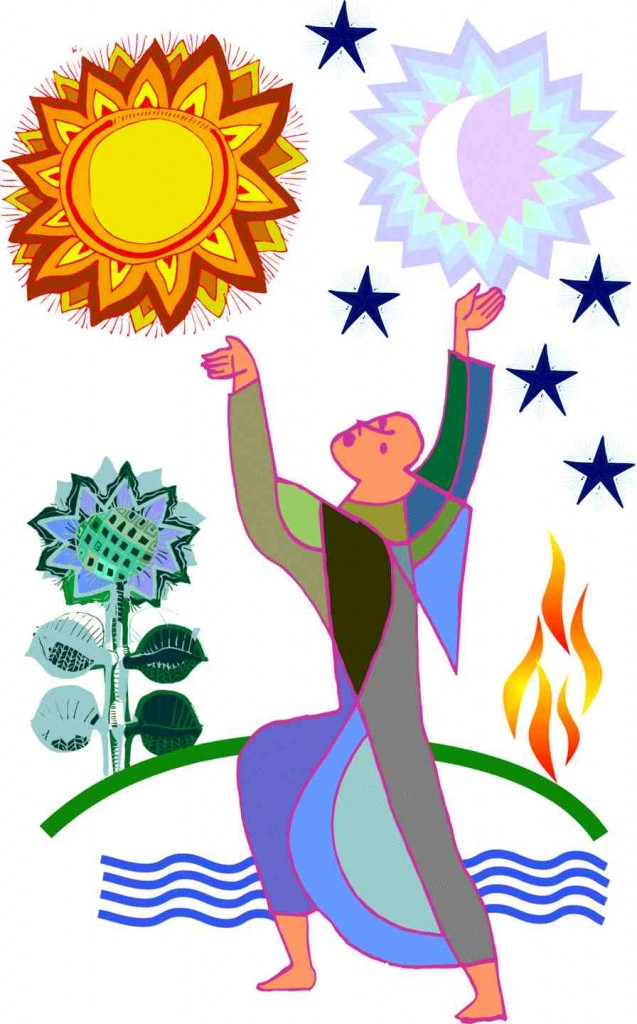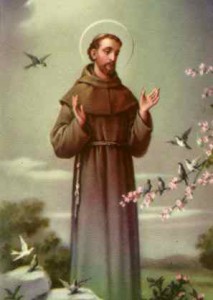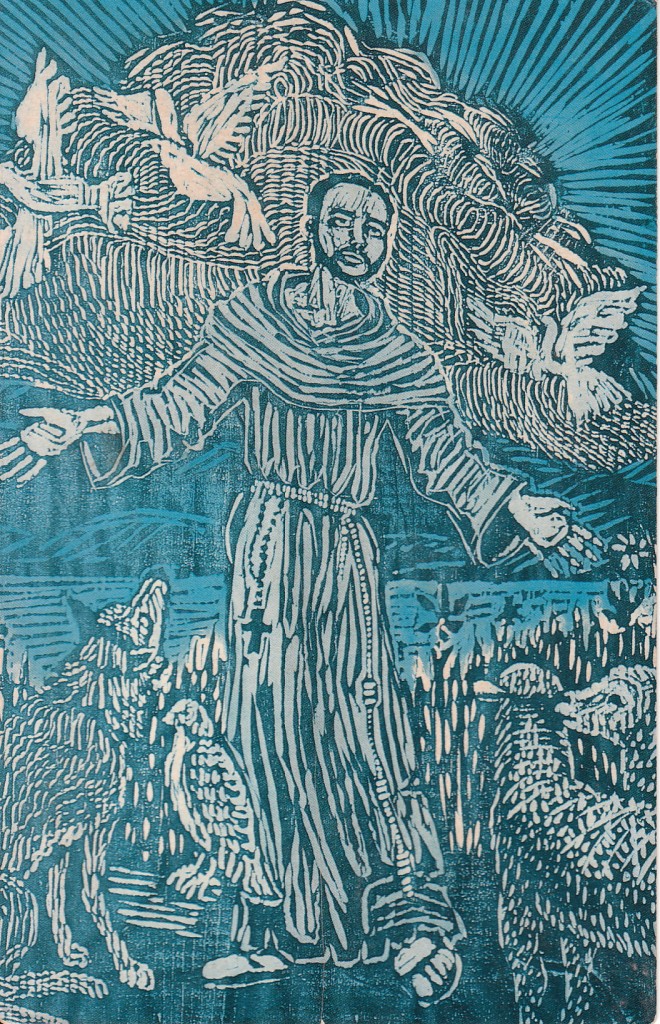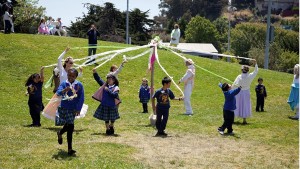Posts Tagged ‘Porziuncola’
Saint Francis of Assisi: His Life and His Prayer
“All the darkness in the world can’t extinguish the light from a single candle.”
~ Francis Of Assisi (The Little Flowers of St. Francis of Assisi)
“If you have men who will exclude any of God’s creatures from the shelter of compassion and pity, you will have men who will deal likewise with their fellow men.”
~ Francis of Assisi
“While you are proclaiming peace with your lips,
be careful to have it even more fully in your heart.”
~ Francis of Assisi
“The deeds you do may be the only sermon some persons will hear today”
~ Francis Of Assisi
“Vi volglio tutti in paradisio!” [ “I wish all in heaven!”]
~ Francis of Assisi
“Above all the grace and the gifts that Christ gives to his beloved is that of overcoming self.”
~ Francis of Assisi
“When we pray to God we must be seeking nothing — nothing.”
“We should seek not so much to pray, but to become prayer.”
~ Francis of Assisi

Saint Francis of Assisi ~ September 26, 1181 – October 3, 1226
Saint Francis of Assisi
[*See footnotes]
Saint Francis of Assisi is one of history’s most beloved saints. For almost eight hundred years since his canonization by the Catholic Church (in the year 1228), he has been remembered and revered not only by Christian denominations, but by countless others world-wide, who have been inspired by his life of universal love, his teachings, and his oneness with Nature.
More than three million people come every year to his tomb in Assisi.
He is patron saint of Italy and of many other places, like San Francisco, a city blessed with his name, his spirit, and a national shrine including the Porziuncola Nuova, the only papally declared holy place in the USA. Also, he is patron saint of birds, animals and ecology and is so remembered on his annual October 4th Feast Day celebration.
Francis loved peace, communed with all living creatures, and lived a life of kindness, simplicity and poverty in contrast to the wealth and apparent corruption of the Church. He was the founder of the Franciscan order of the Catholic Church, and inspired founding of the Poor Clares order for women, and a third secular order for laity sworn to peace.
After living a worldly life of youthful revelry for the first half of his short lifespan, Francis volunteered to fight in a war between Assisi and neighboring Perugia. He was captured during a bloody battle at Collestrada, and was imprisoned and chained in solitude for a year in a dark Perugian dungeon, until ransomed by his wealthy father. Beginning during this time, and thereafter, he suffered a period of protracted physical and psychological illness, remorse and reflection. After fervent prayer, deep introspection, and profuse tears, Francis ultimately decided that money and worldly pleasures meant nothing to him, and as a traumatized battle survivor he came to abhor war. Whereupon, he devoted his life to solitude, prayer, helping the poor, caring for lepers, and promoting peace. Seeing himself as God’s troubadour or fool, he lived in absolute poverty, patterning his life after the life of Jesus and dedicating himself to God.
On returning from a pilgrimage to Rome, where he begged at Church doors for the poor, Francis received a mystical message from Jesus while praying in the ruined church at San Damiano outside of Assisi. There while he was enchantedly gazing at the painted wooden crucifix – a Byzantine image of the crucified Christ still alive on the cross – the silent voice of Jesus telepathically ‘spoke’ to Francesco, instructing him: “Francesco, Francesco, go and repair my house which, as you can see, is falling into ruins.” Thereafter, he devotedly began rebuilding San Damiano and other ruined churches.
Though Saint Francis took literally that mystical message from the crucifix, its true meaning was metaphoric and profound. And by the end of his short lifespan, Saint Francis and his orders had by their example inspired a renaissance of the Catholic Church.
Francis’ exemplary lifestyle inspired and attracted followers who joined with him in his in his Divine mission and life of poverty. Clad in ragged, gray robes with rope belts, they went out barefoot in pairs to spread the Gospel. When they needed food or shelter, they asked someone for it. It was against their rules to “own” anything. Thus, they were known as the “begging brothers”.
In 1209 Francis received permission from Pope Innocent III to form a brotherhood, a religious order of the Church called the “Friars Minor,” (littlest brothers). As “friars” they worked in communities, actively preaching and helping residents, as distinguished from “monks” who then usually lived alone in isolated places. They soon acquired the name “Franciscans”, proliferated and today remain important international symbols and instruments of Francis’ legacy.
The Franciscans’ first headquarters was a simple, tiny chapel near Assisi which Francis received from the Benedictines, and personally restored, naming it “Porziuncola” [“a small portion of land”]. The Porziuncola became Francis’ most beloved and favorite place. Because of his presence and prayers there, it was and continues to be one of the world’s rare holy places. Here, Francis lived, fervently prayed, wrote his rule, created his order of friars minor and consecrated his friend Clara (Chiara), who became Santa Clara, founder of “the poor Clares”, a female religious order dedicated to Franciscan ideals of holiness and poverty. Francis so loved this little place that he chose to die there.
In 1216, while Francis was fervently praying in the Porziuncola, a light filled the chapel and he beheld above the altar a vision of Christ, the Virgin Mary and a company of angels. They asked him what he wanted for the salvation of souls. Francis replied: “Vi volglio tutti in paradisio!” [I wish all in heaven!] And Francis then asked that all those persons who shall come to this church, may obtain a full pardon and remission of all their faults, upon confessing and repenting their sins. The request was granted based on Francis’ worthiness, and the indulgence was later officially confirmed by Pope Honorius III, and became known as “The Pardon of Assisi”.
Francis was extremely democratic and humble. He referred to himself as “little brother Francis” and called all creatures “brothers” and “sisters”. He loved Nature and pantheistically considered it to be the “mirror of God on earth.” He spoke of “Sister Water” and “Brother Tree” and in one of his writings, he referred to “Brother Sun” and “Sister Moon”. There are legends about sermons he preached to trees full of “Sister Birds” in which Francis urged them to sing their prayers of thanks to God. And it is said that rabbits would come to him for protection.
In another legendary story, Francis spoke to a wolf which had been terrifying the entire village of Gubbio, scolding “Brother Wolf” for what he was doing. That wolf not only stopped his attacks but later became a village pet, and was fed willingly by the same villagers, who missed “brother wolf” after he died.
Francis was determined to live the gospels and was strongly influenced and motivated by Jesus’ teachings. “Give to others, and it shall be given to you. Forgive and you shall be forgiven” were his frequent teachings.
Also as a traumatic battle survivor and war hostage Francis cherished peace. So, “Blessed are the peacemakers, for they will be called children of God.” ~ Matthew 5:9 and “love your enemies and pray for those who persecute you.” ~ Matthew 5:44 were often recited by him.
According to a recent biography, Francis was “the first person from the West to travel to another continent with the revolutionary idea of peacemaking.” On a mission of peace, Francis journeyed to Egypt in 1219 idealistically hoping to end the 5th Crusade by converting the Egyptian leader – Sultan Malik al-Kamil – to Christianity. Though his visionary peace mission did not succeed, it proved nonetheless a miraculous portent and important symbol of potential reconciliation between Christians and Muslims and others.
At a time when most Christians demonized Muslims as enemy “infidels”, Francis regarded and treated Muslims with respect, never echoing the negative comments or conduct of his contemporary Christians. Moreover, in Egypt Francis – a devout and gentle peacemaker – was appalled by the crusaders’ sacrilegious brutality.
Francis arrived in Egypt during an ongoing violent and bloody conflict at Damietta, an important city on the Nile, besieged by the Crusaders. There, in the midst of horrible bloodshed, Francis miraculously crossed battle lines totally unarmed and vulnerable, and was able to reach the Sultan’s encampment unharmed and welcomed. Moreover, Francis was admitted to the august presence of the sultan, who was nephew of the great Saladin who had defeated the forces of the ill-fated Third Crusade.
The Sultan was a wise and pragmatic devout Sunni Muslim, influenced by Sufi mystical teachings. He was ready to make peace, and reciprocated Francis’ peaceful and respectful attitude. For at least several days Kamil hosted and dialogued with Francis as an honored guest, before having him safely escorted back to the Crusader encampment. The Sultan – who was amenable to philosophical conversation, but not to conversion – probably noted and honored Francis’ sufi-like appearance and peaceful demeanor, and his regular greeting – “may the Lord give you peace” – uncommon for Christians, but similar to the Arabic “salam aleykum” greeting.
Reciprocally, Francis was deeply impressed by the religious devotion of the Muslims, especially by their fivefold daily call to prayer – call of the muezzin.
On returning to the crusader camp Francis desperately tried to convince Cardinal Pelagio, whom the pope had authorized to lead the 5th Crusade, that he should make peace with the Sultan. But the cardinal who was certain of victory would not listen. His eventual failure, amidst terrible loss of life, brought the barbaric age of the crusades to an ignominious end.
In 1224, near the end of his earthly life, according to legend, Francis became the first saint in history to miraculously receive crucifixion stigmata. It happened after he had been taken to Mount Alverna, a wild nature place in Tuscany, to be in solitude for a forty day retreat.
Though already in a very feeble state, he fasted and prayed intensely with deepest longing for God. In the midst of his fast, while he was so praying he beheld a marvelous vision: an angel carrying an image of a man nailed to a cross. When the vision disappeared, Francis felt sharp pains in various places on his body.
In locating the source of these pains, Francis found that he had five marks or “stigmata” on his hands, feet, and sides—like the wounds inflicted with nails and spears on Jesus during His crucifixion. Those marks remained and caused Francis great pain until his death two years later.
On October 3, 1226 A.D. Francis died in a humble cell next to the beloved Porziuncola, his favorite holy place where the Franciscan movement began. He was blind from trachoma, suffering from malaria and other illnesses, emaciated and racked with pain from the stigmata and other wounds. As he lay dying, the brothers came for his blessing. They sang “Song to the Sun”, a song which Francis had composed.
Sometime before he drew his last breath, he said, “Let us sing the welcome to Sister Death.” Francis welcomed ‘Sister Death’ knowing that “it is in dying that we are reborn to eternal life”, the concluding line of a beautifully inspiring and best known peace prayer mistakenly attributed to him. (**See Footnote)
In conclusion, we offer that prayer in grateful tribute to his blessed life and legacy. May he ever inspire countless beings to become instruments of Divine peace and love, in perfect harmony with Nature and the kingdom of heaven.
“Vi vogliamo tutti in Paradiso”; “We wish ALL in Heaven”.
And so it shall be!

Prayer Of St. Francis Of Assisi **
Beloved, we are instruments of Thy peace.
Where there is hatred, let us sow love;
Where there is injury, pardon;
Where there is doubt, faith;
despair, hope;
darkness, light;
discord, harmony;
sadness, joy;
Divine Mother/Father, grant
that we may seek not so much
to be consoled as to console;
to be understood as to understand;
to be loved, as to BE LOVE.
For it is in giving, that we receive;
It is in pardoning, that we are pardoned;
And it is in dying – to ego life –
that we are reborn to Eternal Life.
Ron’s audio recitation of the Prayer of Saint Francis Of Assisi
Footnotes
* This narrative is based on Ron Rattner’s intuitive interpretation of many disparate and sometimes conflicting historical accounts of the life of Francis of Assisi. The reader is free to accept or reject any part of it.
**This inspiring peace prayer does not appear in any of Saint Francis’ known writings. According to researchers, the first appearance of this prayer was in a French language magazine, La Clochette, in 1912; it was probably then first written by a forgotten Catholic Priest, Father Bouquerel. Later, the prayer was translated into English and widely distributed on cards with a reverse side picture of Saint Francis, without any claim that he wrote the prayer. But, because of his picture and because it invokes his spirit, the prayer thereafter became commonly known as the Prayer of Saint Francis. The foregoing version of the prayer has been edited by Ron Rattner.
A Day of Grace: Rediscovering the Porziuncola ~ a Synchronicity Story
“Every feature of the Porziuncola lifts the heart and mind to God”
~ St. Padre Pio
“The winds of grace are always blowing, but you have to raise the sail.”
~ Sri Ramakrishna
Above all the grace and the gifts that Christ gives to his beloved is that of overcoming self.
~ Francis of Assisi
“The deeds you do may be the only sermon some persons will hear today”
~ Francis Of Assisi
Remember with gratitude,
Life is beatitude –
Even its sorrows and pain;
For we’re all in God’s Grace,
Every time, every place, and
Forever (S)HE will reign!
~ Ron Rattner, Sutra Sayings

Saint Francis of Assisi by Lea Bradovich
A Day of Grace: Rediscovering the Porziuncola
When I moved from Chicago to San Francisco in 1960, I was largely uninformed about religions other than Judaism, and knew virtually nothing about saints. Even though Saint Francis of Assisi was patron saint of my new home, I remained ignorant of his life story until after my profound spiritual opening in 1976.
Then, through a series of synchronistic inner visions and outer events I developed a deep inner rapport with Saint Francis. And his prayer became – and remained – an important part of my daily spiritual practice.
On retirement from law practice in 1992, I made pilgrimages to India and Italy to pay my respects both to my spiritual master Dhyanyogi Madhusudandas and to Saint Francis.
On arriving in Italy in Springtime 1992, I rented a car at the Rome airport and drove northward to the Umbrian town of Assisi, where Francis was born and resided for most of his extraordinary life. As I arrived at the outskirts of Assisi, I immediately experienced a remarkable feeling of déjà vu, and was so overcome with emotion that I had to pull over to the side of the road as I began crying deeply and intensely for a long time.
My subsequent stay in Assisi and excursion to Mount La Verna in Tuscany – where Francis became the first saint to receive the crucifixion stigmata of Christ – proved magical, with unforgettable spiritual experiences.
One of the most profound of those experiences happened as I visited a tiny frescoed chapel called Porziuncola [“the little portion”]. It had been restored from a ruined condition by Francis and his early followers to become first home of the Franciscan order. Here, Francesco lived, wrote his rule, created his order of friars minor and consecrated his friend Clara (Chiara), who became Santa Clara, founder of a female order dedicated to Franciscan ideals of holiness and poverty. Francis so loved this little place that he chose to die there.
As I entered the Porziuncola at Assisi, I experienced a palpable aura of love and was overcome with emotion, cried deeply and intensely and lost track of time. Ever since then, a memory of that exquisitely simple little chapel and its aura of supernal Love has remained enshrined in my heart. Although I have never since returned that holy Assisi place, which Saint Francis named and loved, my cherished memory of the Porziuncola was revived following a surprising and synchronistic ‘holy encounter’ in San Francisco, almost twenty years later. Here’s what happened.
After retirement many years ago, it became my practice to walk almost daily along San Francisco Bay. Most often I walked to the Bay following pedestrian paths beside the Fort Mason Great Meadow, which is part of the Golden Gate National Recreation Area (GGNRA), our nation’s newest National Park.
As I arrived at Fort Mason on a beautiful and sunny June morning, I was obliged to detour from my usual path to the Bay. The National Park Service had closed the pedestrian paths around the Great Meadow for repaving. So to reach the Bay I had to walk across the grassy meadow. There I saw a very unusual sight. Perhaps hundreds of children, attended by mostly senior adults, many dressed in white, were gathered in the meadow. Many tents were set up for children’s activities, such as face painting and fortune telling. Sweet music was playing on loud speakers.
I was quite impressed by this charming scene, of sweet children and caring adults, and I sensed an especially loving atmosphere pervading the meadow. Curious, I asked the first chaperone I encountered, “what’s happening?”. A lovely senior lady told me that this was a children’s fair sponsored by the Meher School of Lafayette (a San Francisco suburb) for its students and for children from less affluent San Francisco neighborhoods, who had also been invited. [*see footnote]
Inspired by the love I perceived and felt there, I continued walking through the meadow and toward the Bay. After hiking out to the end of San Francisco Municipal Pier, I began returning home. Soon, I noticed an unopened bottle of spring water apparently dropped by a cyclist. I picked up the water bottle, determined to give it to someone at the children’s festival in the Great Meadow.
As I arrived again at the meadow, I was met by a tall friendly (and thirsty) man named Peter, who seemed to be watching out at the perimeter of the children’s gathering. Though we’d never met, he somehow seemed familiar. In greeting me Peter asked, “would you like to know what’s happening?” After I recounted what I already knew about the festival and gladly gave Peter the bottle of spring water, he told me more details of this event.
Peter explained that this gathering was like a mini-Umbrian children’s festival inspired by universal values of Saint Francis of Assisi which are similar to those of the Meher School; and, that periodically the school sponsors a play about the life of Francis performed at various venues, including at The National Shrine of Saint Francis of Assisi, located in San Francisco’s oldest church in the North Beach district.
I was very surprised when Peter mentioned a national shrine of Saint Francis of Assisi located in San Francisco. Though I’d then lived in San Francisco more than fifty years, I don’t remember ever before hearing about such a national shrine. Moreover as Peter described the shrine, I was amazed to learn that it included an almost exact replica of the Porziuncola at Assisi, recently constructed at the instance of former San Francisco supervisor Angela Alioto.
Peter and I then exchanged stories about our respective springtime visits to Assisi and our heartfelt affinity with Saint Francis. On parting we shared contact information.
A few days later, I received an email invitation from Peter’s friend and colleague, Terry, to tour the San Francisco Porziuncola shrine, which I quickly accepted. Terry, was both music director of the Meher School’s sponsoring non-profit organization, Sufism Reoriented, and a member of the Knights of St. Francis, a volunteer organization which helps safeguard the national shrine.
The tour proved magical for me. With Terry and Peter as guides, I beheld for the first time the San Francisco “Porziuncola Nuova”. Before entering, I noticed carved in Italian on the second marble step a quote from Francesco: “Vi voglio tutti in Paradiso” [“I want you ALL in Paradise”]. On learning what those words meant, I experienced instant heart-felt emotion and tears.
As I entered the sanctuary that emotion deepened, and soon overcome by it I was obliged to sit silently in a pew, just as I did in Assisi. And, as in Assisi, profuse tears flowed. Unable to talk, I sat and cried for a while as Peter compassionately attempted to comfort me. In the San Francisco Porziuncola I didn’t lose track of time as I did in Assisi, and after crying for a while resumed conversation with Terry and Peter.
But I continued feeling so emotional in that sacred space that I was unable to focus on details of the beautiful pictorial art and artifacts around me, which I later observed on other visits.
I did however notice a prominently displayed letter Tau, the last letter of the Hebrew Alphabet which in biblical times closely resembled the letter T. [See below.] The Tau was adopted by Francesco as his own symbol or logo which he painted on the walls and doors of places where he stayed, and used in his writings as his only signature. (Synchronistically, I had a few days earlier been discussing with a friend possible use of a Tau as a logo for The Perennial Wisdom Foundation, the new non-profit corporation which I was then forming.)
Before exiting the “Porziuncola Nuova” I gazed upon and gently touched one of the holiest Franciscan relics in the world, a beautifully displayed rock believed to have been used by Francis as a crude tool in his reconstruction of the Porziuncola.
After departing the shrine, Terry and Peter and I adjourned for lunch in a nearby restaurant, where we shared stories of how Divine Grace has continuously blessed our lives, as it did on that magical day.
And in now reflecting on that wonderful day of rediscovery, I realize that it couldn’t have happened but for my synchronistic detours through the grassy Great Meadow and desire to share a bottle of spring water which I happened to find while walking by the Bay.
It seems that Divine Grace often works through synchronicity, and that the more alert we become to such synchronicity the more it happens.
What do you think?

Franciscan Tau

